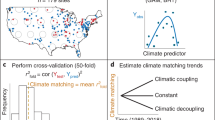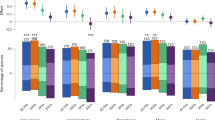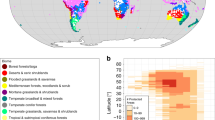Abstract
The dynamic nature and diversity of species’ responses to climate change poses significant difficulties for developing robust, long-term conservation strategies. One key question is whether existing protected area networks will remain effective in a changing climate. To test this, we developed statistical models that link climate to the abundance of internationally important bird populations in northwestern Europe. Spatial climate–abundance models were able to predict 56% of the variation in recent 30-year population trends. Using these models, future climate change resulting in 4.0 °C global warming was projected to cause declines of at least 25% for more than half of the internationally important populations considered. Nonetheless, most EU Special Protection Areas in the UK were projected to retain species in sufficient abundances to maintain their legal status, and generally sites that are important now were projected to be important in the future. The biological and legal resilience of this network of protected areas is derived from the capacity for turnover in the important species at each site as species’ distributions and abundances alter in response to climate. Current protected areas are therefore predicted to remain important for future conservation in a changing climate.
This is a preview of subscription content, access via your institution
Access options
Subscribe to this journal
Receive 12 print issues and online access
$209.00 per year
only $17.42 per issue
Buy this article
- Purchase on Springer Link
- Instant access to full article PDF
Prices may be subject to local taxes which are calculated during checkout





Similar content being viewed by others
References
Huntley, B., Green, R. E., Collingham, Y. C. & Willis, S. G. A Climatic Atlas of European Breeding Birds (Lynx Edicions, 2007).
Chen, I-C., Hill, J. K., Ohlemüller, R., Roy, D. B. & Thomas, C. D. Rapid range shifts of species associated with high levels of climate warming. Science 333, 1024–1026 (2011).
Bellard, C., Bertelsmeier, C., Leadley, P., Thuiller, W. & Courchamp, F. Impacts of climate change on the future of biodiversity. Ecol. Lett. 15, 365–377 (2012).
Devictor, V. et al. Differences in the climatic debts of birds and butterflies at a continental scale. Nature Clim. Change 2, 121–124 (2012).
Ferrier, S., Harwood, T. & Williams, K. J. Using Generalised Dissimilarity Modelling to Assess Potential Impacts of Climate Change on Biodiversity Composition in Australia, and on the Representativeness of the National Reserve System (Department of Sustainability, Environment, Water, Population and Communities, 2010).
Lemieux, C. J. & Scott, D. J. Climate change, biodiversity conservation and protected area planning in Canada. Can. Geogr 49, 384–397 (2005).
Hole, D. G. et al. Projected impacts of climate change on a continent-wide protected area network. Ecol. Lett. 12, 420–431 (2009).
Araújo, M. B., Alagador, D., Cabeza, M., Nogues-Bravo, D. & Thuiller, W. Climate change threatens European conservation areas. Ecol. Lett. 14, 484–492 (2011).
Thomas, C. D. et al. Protected areas facilitate species’ range expansions. Proc. Natl Acad. Sci. USA 109, 14063–14068 (2012).
McCarthy, M. A., Thompson, C. J. & Possingham, H. P. Theory for designing nature reserves for single species. Am. Nat. 165, 250–257 (2005).
McCarthy, M. A., Thompson, C. J. & Williams, N. S. G. Logic for designing nature reserves for multiple species. Am. Nat. 167, 717–727 (2006).
McCarthy, M. A., Thompson, C. J., Moore, A. L. & Possingham, H. P. Designing nature reserves in the face of uncertainty. Ecol. Lett. 14, 470–475 (2011).
Stroud, D. A. et al. The UK SPA Network: Its Scope and Content (JNCC, 2001).
Peery, M. Z., Gutierrez, R. J., Kirby, R., Ledee, O. E. & Lahaya, W. Climate change and spotted owls: Potentially contrasting responses in the Southwestern United States. Glob. Change Biol. 18, 865–880 (2012).
Renwick, A. R., Massimino, D., Newson, S. E., Pearce-Higgins, J. W. & Johnston, A. Modelling changes in species’ abundance in response to projected climate change. Divers. Distrib. 18, 121–132 (2012).
Huntley, B., Altwegg, R., Barnard, P., Collingham, Y. C. & Hole, D. G. Modelling relationships between species spatial abundance patterns and climate. Glob. Ecol. Biogeogr. 21, 668–681 (2012).
Donald, P. F. et al. International conservation policy delivers benefits for birds in Europe. Science 317, 810–813 (2007).
Dodd, A. M., Hardiman, A., Jennings, K. & Williams, G. Protected areas and climate change: Reflections from a practitioner’s perspective. Utrecht L. Rev. 6, 141–150 (2010).
Dodd, A. M. et al. Protected areas and wildlife in changing landscapes: The law and policy context for NGO responses to climate change in the UK. J. Int. Wildlife Law Policy 15, 1–24 (2012).
Cliquet, A., Backes, C., Harris, J. & Howsam, P. Adaptation to climate change: Legal challenges for protected areas. Utrecht L. Rev. 5, 158–175 (2009).
Beale, C. M., Lennon, J. J. & Gimona, A. Opening the climate envelope reveals no macroscale associations with climate in European birds. Proc. Natl Acad. Sci. USA 105, 14908–14912 (2008).
Mitchell, P. I., Newton, S. F., Ratcliffe, N. & Dunn, T. E. Seabird Populations of Britain and Ireland (T. & A.D. Poyser, 2004).
Green, R. E. et al. Performance of climate envelope models in retrodicting recent changes in bird population size from observed climatic change. Biol. Lett. 4, 599–602 (2008).
Gregory, R. D. et al. An indicator of the impact of climatic change on European bird populations. PLoS ONE 4, e4678 (2009).
Jiguet, F. et al. Population trends of European common birds are predicted by characteristics of their climatic niche. Glob. Change Biol. 16, 497–505 (2010).
Aebischer, N. J., Coulson, J. C. & Colebrookl, J. M. Parallel long-term trends across four marine trophic levels and weather. Nature 347, 753–755 (1990).
Frederiksen, M., Edwards, M., Mavor, R. A. & Wanless, S. Regional and annual variation in black-legged kittiwake breeding productivity is related to sea surface temperature. Mar. Ecol. Prog. Ser. 350, 137–143 (2007).
Riou, S. et al. Recent impacts of anthropogenic climate change on a higher marine predator in western Britain. Mar. Ecol. Prog. Ser. 422, 105–112 (2011).
Oswald, S. A., Bearhop, S., Furness, R. W., Huntley, B. & Hamer, K. C. Heat stress in a high-latitude seabird: Effects of temperature and food supply on bathing and nest attendance of great skuas Catharacta skua. J. Avian Biol. 39, 163–169 (2008).
Piersma, T., Rogers, K. G., Boyd, H., Bunskoeke, E. J. & Jukema, J. Demography of Eurasian Golden Plovers Pluvialis apricaria in The Netherlands, 1949–2000. Ardea 93, 49–64 (2005).
Kéry, M., Madsen, J. & Lebreton, J. D. Survival of Svalbard pink-footed geese Anser brachyrhynchus in relation to winter climate, density and land-use. J. Animal Ecol. 75, 1172–1181 (2006).
Van de Pol, M. et al. Effects of climate change and variability on population dynamics in a long-lived shorebird. Ecology 91, 1192–1204 (2010).
Murphy, J. M. et al. UK Climate Projections Science Report: Climate Change Projections (Met Office Hadley Centre, 2009).
Eaton, M. A. et al. Birds of conservation concern 3: The population status of birds in the United Kingdom, Channel Islands and the Isle of Man. Brit. Birds 102, 296–341 (2009).
Maclean, I. M. D. et al. Climate change causes rapid changes in the distribution and site abundance of birds in winter. Glob. Change Biol. 14, 2489–2500 (2008).
Lehikoinen, A. et al. Rapid climate driven shifts in wintering distribution of waterfowl. Glob. Change Biol. 19, 2071–2081 (2013).
Nenzén, H. K. & Araújo, M. B. Choice of threshold alters projections of species range shifts under climate change. Ecol. Model. 222, 3346–3354 (2011).
Gaston, K. J. & Lawton, J. H. Effects of scale and habitat on the relationship between regional distribution and local abundance. Oikos 58, 329–335 (1990).
Austin, G. E. & Rehfisch, M. M. Shifting nonbreeding distributions of migratory fauna in relation to climate change. Glob. Change Biol. 11, 31–38 (2005).
Walther, G-R. Community and ecosystem responses to recent climate change. Phil. Trans. R. Soc. B 365, 2019–2024 (2010).
Hannah, L. et al. Protected area needs in a changing climate. Front. Ecol. Environ. 5, 131–138 (2007).
Designating Ramsar Sites: Strategic Framework and Guidelines for the Future Development of the List of Wetlands of International Importance (Ramsar Convention Secretariat, 2010).
Atkinson-Willes, G. L., Scott, D. A. & Prater, A. J. Criteria for selecting wetlands of international importance. Supplemento alle Ricerche di Biologia della Selvaggina 81, 1017–1042 (1980).
Dunlop, M. & Brown, P. R. Implications of Climate Change for Australia’s National Reserve System: A Preliminary Assessment (Department of Climate Change, 2008).
Haylock, M. R. et al. A European daily high-resolution gridded dataset of surface temperature and precipitation. J. Geophys. Res. 113, D20119 (2008).
Crick, H. Q. P., Dudley, C., Glue, D. E. & Thomson, D. L. UK birds are laying eggs earlier. Nature 388, 526 (1997).
Snow, D. & Perrins, C. M. The Birds of the Western Palaearctic (Concise Edition) (Oxford Univ. Press, 2004).
R Development Core Team R: A Language and Environment for Statistical Computing (R Foundation for Statistical Computing, 2012).
Picard, R. R. & Cook, R. D. Cross-validation of regression models. J. Am. Statist. Assoc. 79, 575–583 (1984).
Jenkins, G. et al. UK Climate Projections: Briefing Report Version 2 (Met Office Hadley Centre, 2010).
Acknowledgements
This project was funded by Defra with the support of the Joint Nature Conservation Committee, Natural England, Countryside Council for Wales and Scottish Natural Heritage. We would like to thank all the professional and amateur ornithologists who contributed to the collection of bird data. We also acknowledge the provision of bird data from the UK, Ireland, France and the Netherlands, which included schemes coordinated or contributed to by BirdWatch Ireland, British Trust for Ornithology, Countryside Council for Wales, Environment and Heritage Service for Northern Ireland, Groupement d’Intérêt Scientifique Oiseaux Marins, International Waterbird Census, Joint Nature Conservation Committee, Ligue pour la Protection des Oiseaux, National Parks and Wildlife Service, Natural England, Royal Society for the Protection of Birds, Scottish Natural Heritage, SOVON Dutch Centre for Field Ornithology and the Wildfowl and Wetlands Trust. Weather data were provided by UKCP09 and E-OBS from the EU-FP6 project ENSEMBLES, and future climate projections were from UKCP09. Other data were provided by the International Centre for Tropical Agriculture, Ordnance Survey and Joint Nature Conservation Committee. We acknowledge input from G. Austin, I. Burfield, N. Burton, C. Campbell, N, Clark, G. Conway, D. Fouracre and S. Wotton.
Author information
Authors and Affiliations
Contributions
A.J., J.W.P-H. and C.D.T. wrote the article, with significant input from M.A., A.M.D., R.B.B., D.E.C. andF.J., and all other authors contributed to the manuscript. A.B., H.P., M.M.R., D.E.C., A.J., J.P.H., A.M.D., M.A., F.J., R.B.B. and C.D.T. designed the study. A.J., N.O., C.B.T. and S.E.N. ran models and analysed results. A.J., S.R., B.C., A.S.C.P.C., O.C., B.D., M.H., F.J. and N.O. collated and prepared data. D.A.S., R.A.M., A.D., A.B., H.Q.P.C. and H.P. provided scientific advice throughout the project.
Corresponding authors
Ethics declarations
Competing interests
The authors declare no competing financial interests.
Supplementary information
Rights and permissions
About this article
Cite this article
Johnston, A., Ausden, M., Dodd, A. et al. Observed and predicted effects of climate change on species abundance in protected areas. Nature Clim Change 3, 1055–1061 (2013). https://doi.org/10.1038/nclimate2035
Received:
Accepted:
Published:
Issue Date:
DOI: https://doi.org/10.1038/nclimate2035
This article is cited by
-
Current and future distribution pattern of Cochlospermum planchonii and Cochlospermum tinctorium in Benin (West Africa), in response to climate change scenario
Modeling Earth Systems and Environment (2022)
-
Multi-taxa spatial conservation planning reveals similar priorities between taxa and improved protected area representation with climate change
Biodiversity and Conservation (2022)
-
Crossroad for bird migration: France should improve the conservation of its key-wetland sites used by 6 million waterbirds
European Journal of Wildlife Research (2022)
-
Responses of global waterbird populations to climate change vary with latitude
Nature Climate Change (2020)
-
Can microclimate offer refuge to an upland bird species under climate change?
Landscape Ecology (2020)



